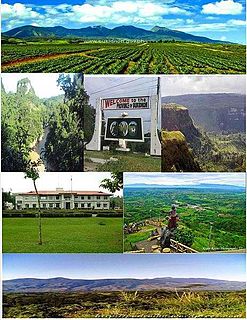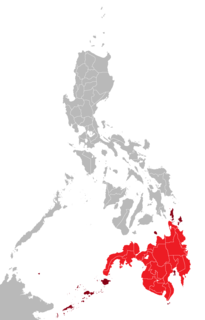
Mindanao or still commonly known as Southern Philippines, is the second-largest island in the Philippines. Mindanao and the smaller islands surrounding it make up the island group of the same name. Located in the southern region of the archipelago, as of the 2010 census, the main island was inhabited by 20,281,545 people, while the entire Mindanao island group had an estimated total of 25,537,691 (2018) residents.

Zamboanga del Sur is a province in the Philippines located in the Zamboanga Peninsula region in Mindanao. Its capital is the city of Pagadian. Incorrectly grouped with Zamboanga del Sur is the highly urbanized city of Zamboanga, which is a chartered city and governed independently from the province.

Mount Apo is a large solfataric, potentially active stratovolcano on the island of Mindanao, Philippines. With an elevation of 2,954 meters (9,692 ft) above sea level, it is the highest mountain in the Philippine Archipelago and is located between Davao City and Davao del Sur province in Region XI and Cotabato in Region XII. The peak overlooks Davao City 45 kilometers (28 mi) to the northeast, Digos 25 kilometers (16 mi) to the southeast, and Kidapawan 20 kilometers (12 mi) to the west.

Davao del Sur is a province in the Philippines located in the Davao Region in Mindanao. Its capital and largest city is Digos. The province is bordered by Davao City to the north, Davao Occidental to the south and Cotabato, Sultan Kudarat, South Cotabato and Sarangani to the west. To the east lies the Davao Gulf.

Davao Region, formerly called Southern Mindanao, is an administrative region in the Philippines, designated as Region XI. It is situated at the southeastern portion of Mindanao, comprising five provinces: Compostela Valley, Davao del Norte, Davao del Sur, Davao Oriental and Davao Occidental, the newly created province.
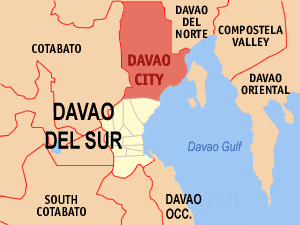
Davao City, officially the City of Davao, is a 1st class highly urbanized city in the island of Mindanao, Philippines. The city has a total land area of 2,443.61 km2 (943.48 sq mi), making it the largest city in the Philippines in terms of land area. It is the third-most populous city in the Philippines after Quezon City and Manila, the most populous city in the country outside Metro Manila, and the most populous in Mindanao. As of the 2015 census, the city had a population of 1,632,991.

Tagum, officially the City of Tagum,, or simply referred to as Tagum City, is a 1st class city and capital of the Davao del Norte, Philippines. According to the 2015 census, it has a population of 259,444 people making it the most populous component city in Mindanao.

Liloy, officially the Municipality of Liloy, is a 3rd class municipality in the province of Zamboanga del Norte, Philippines. According to the 2015 census, it has a population of 39,812 people.
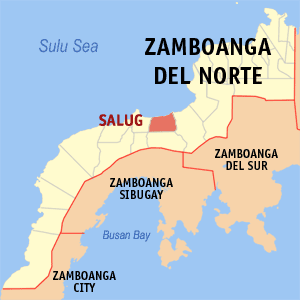
Salug, officially the Municipality of Salug,, is a 3rd class municipality in the province of Zamboanga del Norte, Philippines. According to the 2015 census, it has a population of 32,204 people.

San Fernando, officially the Municipality of San Fernando, is a 1st class municipality in the province of Bukidnon, Philippines. According to the 2015 census, it has a population of 56,138 people.

Mahayag, officially the Municipality of Mahayag, is a 3rd class municipality in the province of Zamboanga del Sur, Philippines. According to the 2015 census, it has a population of 46,516 people.

Molave, officially known as the Municipality of Molave, is a 1st class municipality in the province of Zamboanga del Sur, Philippines. According to the 2015 census, it has a population of 52,006 people.
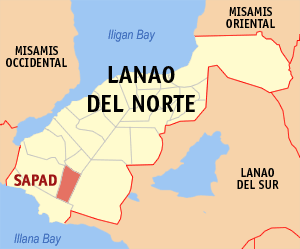
Sapad, officially the Municipality of Sapad, is a 5th class municipality in the province of Lanao del Norte, Philippines. According to the 2015 census, it has a population of 21,309 people.

The Lumad are a group of Austronesian indigenous people in the southern Philippines. It is a Cebuano term meaning "native" or "indigenous". The term is short for Katawhang Lumad, the autonym officially adopted by the delegates of the Lumad Mindanao Peoples Federation (LMPF) founding assembly on 26 June 1986 at the Guadalupe Formation Center, Balindog, Kidapawan, Cotabato, Philippines. It is the self-ascription and collective identity of the indigenous peoples of Mindanao.
The Matigsalug are the Bukidnon groups who are found in the Tigwa-Salug Valley in San Fernando in Bukidnon province, Philippines. "Matigsalug" is a term, which means "people along the Salug River ". Although often classified under the Manobo ethnolinguistic group, the Matigsalug is a distinct sub-group of indigenous peoples from the Manobos.

The Manobo languages are a group of languages spoken in the Philippines. All go by the name Manobo or Banobo. Their speakers are primarily located around Northern Mindanao, Central Mindanao and Caraga regions where they are natively spoken. Some outlying groups make Manobo geographically discontiguous as other speakers can be located as far as the southern peninsula of Davao Oriental, southern parts of Davao del Sur and coastal areas of Sultan Kudarat. The Kagayanen speakers are the most extremely remote and can be found in certain portions of Palawan.
Giangan is an Austronesian language of the southern Philippines. It is spoken on the eastern slopes of Mount Apo in Davao del Sur Province, as well as in Davao City (Ethnologue). They occupy a very small territory stretching from Catalunan to Calinan within Davao City.
Matigsalug is a Manobo language of Mindanao in the Philippines. It is a Central Philippine language that belongs to the Malayo-Polynesian subgroup of the Austronesian language family. There are four major dialects: Kulamanen, Tigwa, Tala Ingod, and Matigsalug Proper. Dialects are divergent, such that Tigwa has marginal intelligibility of Matigsalug, and only Tala Ingod may have adequate intelligibility of Matigsalug. There are approximately 5,000 monolinguals, but have at least 50,000 speakers; most of whom are concentrated in Mindanao, notably in south central Bukidnon, North Cotabato (northeast), and northwestern Davao del Sur provinces.
